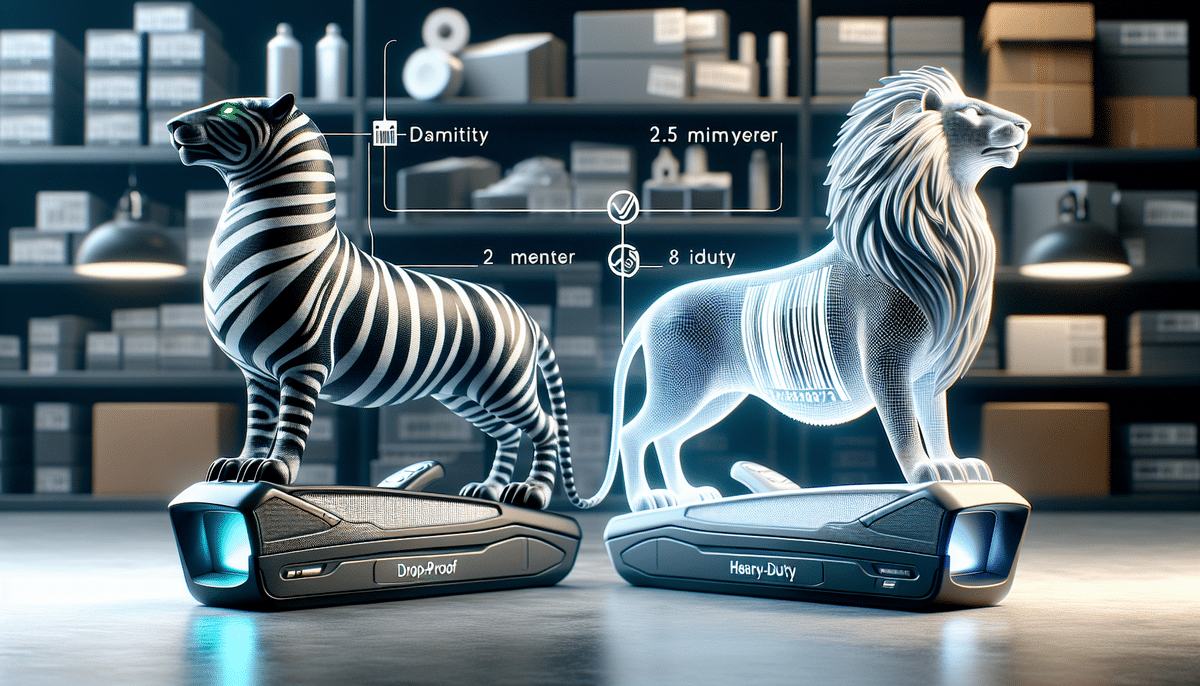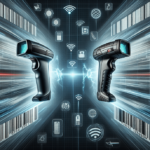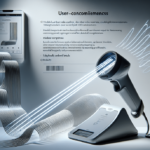Zebra DS2208 vs Datalogic Gryphon I GD4500: Comprehensive Barcode Scanner Comparison
Barcodes are integral to modern commercial and industrial operations, streamlining tasks from inventory management to shipment tracking. Selecting the right barcode scanner can significantly boost your enterprise's operational efficiency. Among the top contenders in the market are the Zebra DS2208 and the Datalogic Gryphon I GD4500. This article provides an in-depth comparison to help you make an informed decision.
Product Overviews
Zebra DS2208 Barcode Scanner
The Zebra DS2208 is celebrated for its versatility, capable of reading both 1D and 2D barcodes of various sizes and resolutions. It supports omni-directional and handheld scanning, making it adaptable to diverse operational demands. The scanner’s lightweight and ergonomic design ensures user comfort during extended use, minimizing operator fatigue. Its plug-and-play interface simplifies installation and connectivity with other devices.
Constructed for durability, the DS2208 withstands drops from up to 5 feet, making it ideal for bustling environments where accidental drops are common. It also features a long battery life, allowing for prolonged usage without frequent recharging. According to Zebra's official specifications, the DS2208 enhances efficiency and streamlines operations across various industries.
Datalogic Gryphon I GD4500 Barcode Scanner
The Datalogic Gryphon I GD4500 supports both 1D and 2D barcode scanning and incorporates motion-sensing technology, enabling hands-free scanning without the need to press a button. This feature increases scanning speed and overall efficiency. The scanner boasts a sleek, modern design with high-quality build materials, ensuring both aesthetic appeal and durability.
Its intuitive user interface is easy to navigate, and it connects seamlessly to devices via cable or Bluetooth. The Gryphon I GD4500 is built to endure drops from heights up to 6 feet, making it suitable for demanding settings such as warehouses and retail stores. Advanced imaging technology allows it to accurately read barcodes even in low-light conditions, ensuring reliable performance. For more details, visit Datalogic’s official product page.
Scanning Capabilities
Both scanners excel in scanning capabilities but exhibit distinct differences:
- Zebra DS2208: Offers a scanning range of up to 21 inches and a high scanning speed of 700 scans per second for 1D barcodes. Its wide field of view allows it to capture barcodes from various angles and orientations.
- Datalogic Gryphon I GD4500: Extends the scanning range up to 39 inches and features motion-sensing technology for faster, more efficient scanning. It supports both 1D and 2D barcodes with a scanning speed of 450 scans per second.
While the DS2208 outperforms in scanning speed and field of view, the Gryphon I GD4500 offers superior range and motion-sensing capabilities. According to IDC Reports, selecting the right scanning capabilities can enhance operational efficiency by up to 30%.
Pricing and Value for Money
The Zebra DS2208 is generally more affordable compared to the Datalogic Gryphon I GD4500. For businesses operating on a strict budget, the DS2208 offers excellent value with its robust feature set and lower total cost of ownership.
Conversely, the Gryphon I GD4500 justifies its higher price point with advanced features like motion-sensing technology and greater durability, making it suitable for high-demand environments. Enterprises in manufacturing or logistics may find the additional investment worthwhile for the enhanced performance and longevity.
For current pricing information, visit the respective Zebra DS2208 and Datalogic Gryphon I GD4500 product pages.
Design and Ergonomics
The design of both scanners is modern and aesthetically pleasing, each offering distinct ergonomic features:
- Zebra DS2208: Features a comfortable grip and a larger scanning window, facilitating the scanning of larger items. Its lightweight design ensures ease of use over extended periods.
- Datalogic Gryphon I GD4500: Boasts an intuitive button layout that supports one-handed use. The wider scanning angle enhances scanning accuracy and speed.
Ergonomic design is crucial in reducing operator fatigue and boosting productivity. Studies by Ergonomics International indicate that ergonomic improvements can increase operator efficiency by up to 25%.
Connectivity Options and Compatibility
Both scanners offer robust connectivity options to ensure seamless integration with existing systems:
- Zebra DS2208: Supports USB, Bluetooth, RS-232, and keyboard wedge connections, ensuring compatibility with a wide range of devices including point-of-sale systems, laptops, and smartphones.
- Datalogic Gryphon I GD4500: Offers USB and Bluetooth connectivity, with advanced technology that allows connection to multiple host devices simultaneously. It also features "Green Spot" technology for visual scan confirmation.
The Zebra DS2208's versatility in connectivity makes it suitable for businesses using diverse systems. In contrast, the Gryphon I GD4500’s ability to connect with multiple devices simultaneously is advantageous for larger organizations with multiple users. For more information on compatibility, refer to the Zebra DS2208 and Datalogic Gryphon I GD4500 specifications.
Durability and Longevity
Both scanners are built to last, but they have different durability ratings:
- Zebra DS2208: Designed to withstand up to 2,500 drops from a height of six feet, providing a longer lifespan with an estimated duration of 5 years.
- Datalogic Gryphon I GD4500: Capable of withstanding up to 600 drops from six feet, with an estimated lifespan of 3 years.
Regular maintenance and proper care can extend the longevity of both scanners. The Zebra DS2208 offers greater durability, making it a preferable choice for environments with rigorous usage. For more details on durability standards, consult the Zebra DS2208 datasheet and the Datalogic Gryphon I GD4500 datasheet.
Customer Reviews and Satisfaction
Customer feedback highlights high satisfaction levels for both scanners:
- Zebra DS2208: Users appreciate its fast scanning speed, ergonomic design, and ease of setup. It is frequently praised for its reliability in high-volume environments.
- Datalogic Gryphon I GD4500: Customers commend its motion-sensing technology, durable build, and intuitive interface. The "Green Spot" feature for scan confirmation is particularly valued in noisy or dimly lit settings.
While both scanners receive positive reviews, some users note that the DS2208 offers slightly faster scanning speeds, whereas the GD4500 excels in user-friendliness and advanced features. Refer to customer testimonials on the Zebra DS2208 reviews and Datalogic Gryphon I GD4500 reviews for detailed insights.
Expert Recommendations for Various Environments
Based on a comprehensive analysis, here are expert recommendations tailored to different business needs:
- Small to Medium Businesses: The Zebra DS2208 is ideal due to its affordability, versatility, and high scanning speed, making it suitable for retail and light industrial applications.
- High-Demand Industrial Environments: The Datalogic Gryphon I GD4500 is recommended for its advanced scanning technology, durability, and ability to connect with multiple devices, making it perfect for manufacturing, logistics, and large-scale retail operations.
Considerations such as barcode types, software compatibility, and specific operational requirements should also influence your decision. For instance, businesses extensively using 2D barcodes might explore options like the Honeywell Xenon 1902 for enhanced 2D scanning capabilities.
Future Advancements in Barcode Scanning Technology
The barcode scanning industry is rapidly evolving, with advancements in artificial intelligence (AI) and machine learning set to revolutionize scanner capabilities. Future developments may include:
- Enhanced Barcode Recognition: AI-powered scanners will better recognize and decode damaged or poorly printed barcodes, increasing reliability.
- Adaptive Scanning Settings: Scanners will automatically adjust settings based on the type of barcode and environmental conditions, optimizing performance.
- Mobile Integration: The rise of mobile devices as barcode scanners could lead to a shift towards mobile apps, reducing reliance on dedicated scanners like the DS2208 and Gryphon I GD4500.
Despite these advancements, both the Zebra DS2208 and Datalogic Gryphon I GD4500 remain relevant due to their robust features and reliability. As technology progresses, these models may integrate some of the new advancements to maintain their competitive edge.
Final Verdict: Which Scanner is the Superior Option?
Determining the superior scanner depends on your business's specific needs:
- Zebra DS2208: Best suited for businesses seeking an affordable, versatile barcode scanner with high scanning speeds and a wide field of view. Ideal for small to medium-sized enterprises looking to enhance productivity without significant investment.
- Datalogic Gryphon I GD4500: Optimal for high-demand environments that require advanced features such as motion-sensing technology and multi-device connectivity. Suited for larger organizations in manufacturing, logistics, and extensive retail operations.
Ultimately, both scanners offer robust performance and reliability. Assess your unique operational requirements, budget constraints, and long-term business goals to select the barcode scanner that best fits your organization's needs.




















